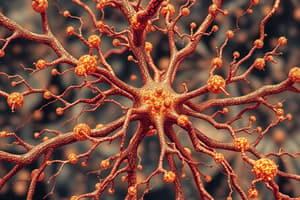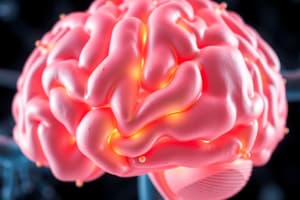Podcast
Questions and Answers
What role does calcium ($Ca^{2+}$) play in neurotransmitter release?
What role does calcium ($Ca^{2+}$) play in neurotransmitter release?
- It directly opens ion channels on the postsynaptic neuron.
- It initiates the breakdown of neurotransmitters in the synaptic cleft.
- It binds to neurotransmitters, making them active.
- It causes the synaptic vesicles to fuse with the presynaptic neuron's membrane. (correct)
Which of the following best describes the 'all-or-none' law regarding action potentials?
Which of the following best describes the 'all-or-none' law regarding action potentials?
- The intensity of the action potential is determined by the number of open ion channels.
- The neuron either fires a full action potential or does not fire at all. (correct)
- The neuron gradually increases its firing rate as the stimulus intensity increases.
- A stronger stimulus results in a larger action potential.
What is the primary effect of inhibitory neurotransmitters on the postsynaptic neuron?
What is the primary effect of inhibitory neurotransmitters on the postsynaptic neuron?
- They cause depolarization by allowing sodium ($Na^+$) ions to enter the neuron.
- They cause hyperpolarization by allowing potassium ($K^+$) ions to exit the neuron. (correct)
- They trigger the release of calcium ($Ca^{2+}$) ions from internal stores.
- They directly initiate the production of new neurotransmitters.
Which of the following is NOT a mechanism for removing neurotransmitters from the synaptic cleft?
Which of the following is NOT a mechanism for removing neurotransmitters from the synaptic cleft?
What is the significance of the refractory period following an action potential?
What is the significance of the refractory period following an action potential?
How does spatial summation contribute to a neuron reaching its threshold for firing an action potential?
How does spatial summation contribute to a neuron reaching its threshold for firing an action potential?
If a neuron is at rest (-70mV), what membrane potential must it reach in order to fire an action potential?
If a neuron is at rest (-70mV), what membrane potential must it reach in order to fire an action potential?
What is the difference between temporal and spatial summation?
What is the difference between temporal and spatial summation?
Flashcards
Neurotransmitter Release
Neurotransmitter Release
The process where presynaptic neurons release neurotransmitters into the synaptic cleft.
Action Potential
Action Potential
A rapid rise and fall in electrical charge that travels down a neuron.
Excitatory Neurotransmitters
Excitatory Neurotransmitters
Chemicals that increase the likelihood of a neuron firing by causing depolarization.
Inhibitory Neurotransmitters
Inhibitory Neurotransmitters
Signup and view all the flashcards
Summation
Summation
Signup and view all the flashcards
Refractory Period
Refractory Period
Signup and view all the flashcards
Spatial Summation
Spatial Summation
Signup and view all the flashcards
Temporal Summation
Temporal Summation
Signup and view all the flashcards
Study Notes
Neuronal Communication: Steps & Mechanisms
-
Neurotransmitter Release (Step 1):
- Presynaptic neurons store neurotransmitters in vesicles within axon terminals.
- Action potential triggers calcium (Ca²⁺) influx into the terminal.
- Calcium prompts vesicle fusion with the membrane, releasing neurotransmitters into the synaptic cleft.
- Neurotransmitters diffuse across the synapse.
-
Neurotransmitter Binding & Ion Channel Opening (Step 2):
- Neurotransmitters bind to specific receptors on postsynaptic neuron dendrites.
- Binding opens ion channels, altering the neuron's electrical potential.
- Resting potential is -70 mV; threshold for firing is -55 mV.
- Excitatory neurotransmitters (e.g., increasing sodium (Na⁺) influx) lead to depolarization, increasing firing likelihood.
- Inhibitory neurotransmitters (e.g., increasing potassium (K⁺) efflux) lead to hyperpolarization, decreasing firing likelihood.
- Neurotransmitters detach and are removed by diffusion, enzymatic breakdown, or reuptake.
-
Signal Summation (Step 3):
- Neuron integrates excitatory (EPSPs) and inhibitory (IPSPs) signals in the soma.
- Spatial summation: signals from different locations at the same time.
- Temporal summation: signals from the same location in quick succession.
- If summed signals reach -55 mV, the neuron fires an action potential.
-
Action Potential & Refractory Period (Step 4):
- Action Potential initiation: Sodium (Na⁺) influx drives voltage to +40 mV.
- Action potential propagates along the axon.
- All-or-none principle: Neuron fires completely or not at all; strength of stimulus affects firing frequency, not action potential strength.
- Repolarization : Potassium (K⁺) efflux restores the previous negative charge after firing (refractory period).
- Neuron returns to resting potential (-70mV) preparing for another action potential.
Studying That Suits You
Use AI to generate personalized quizzes and flashcards to suit your learning preferences.





